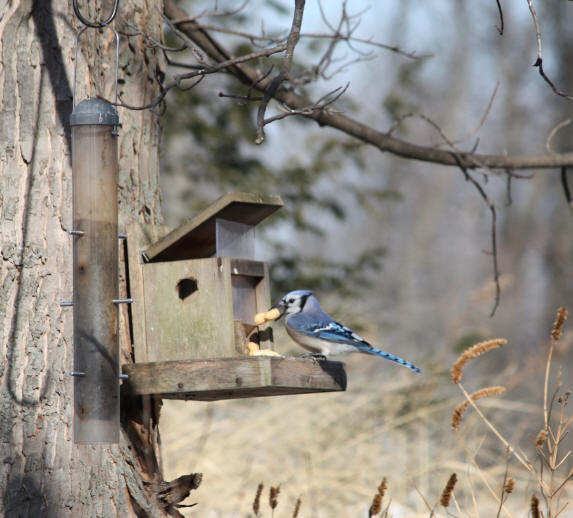Now is the time to be thinking about feeding the many beautiful, fine-feathered friends who remain in our area for the winter. Providing food and water will attract a variety of birds, delighting us with their beautiful colors against the snow and
perching on barren tree limbs singing melodic tunes. We can enjoy their presence all winter while we are housebound.
Bird feeding does not give instant gratification. When a feeder is placed outdoors, you may find only a few birds will feed at first. Depending on the menu you offer, those who do dine with you will probably spread the word and you will find your
dining spot increase by leaps and bounds. But, remember you will be taking on a responsibility when feeding those birds. They will come to depend on you since natural food is limited in the winter. Water is also needed when ponds and creeks have frozen over. Water can be
set out several times a day because it will most likely freeze.
What kind of birdfeeders can be used? There are tube feeders made with clear plastic so that you can see when feed is getting low. The tiny, small perches are perfect for small birds but discouraging for the larger birds you may not be interested in.
Although suet (beef fat) can be made with plastic mesh bags that are used for onions, this method can be harmful for small birds if the mesh tears and they become tangled in the mesh.

Tray feeders can be used almost anywhere. The disadvantage is they are messy. Birds may scatter as much seed over the edge of the tray as they actually eat. Of course, the ground-feeding Mourning Doves and other birds will enjoy the spillage. There
are many different bird feeders available; however, Iíve had more success with just placing a pie tin filled with seed out on the ground or on top of the snow.
Some birds eat a variety of foods, while others are quite particular. Choosing the right seed can help attract the birds you want and discourage those you do not want. The following is a list of the most common seed available at most stores that
carry pet feed supplies: Sunflower seed, Thistle, Millet, Cracked Corn, Suet, feed shaped into bells, scraps of leftover bread, apples and nuts.
Making fatty feeders can be an indoor project for children, supervised by an adult. You will need the following supplies:
- small bowl
- selection of birdseed, nuts and fruit, bread
- bacon fat, lard or shortening
- small saucepan
- small plastic container (such as an empty yogurt container)
Fill the a bowl with birdseed, nuts, apples, cranberries, bread and anything else you think birds might enjoy. Mix everything together in the small bowl.
The grownup supervising this project can melt about Ĺ c. of fat or shortening in saucepan and pour over mixture in the small bowl. Leave it in a cool place to set. until hardened. When the fat has hardened, carefully pull of the plastic pot, and your
feeder is ready to sit on a feeder tray on a bird table or windowsill.
Read other articles on birds, wildlife & beneficial insects
Read other winter related gardening articles
Read other articles by Carol Morton